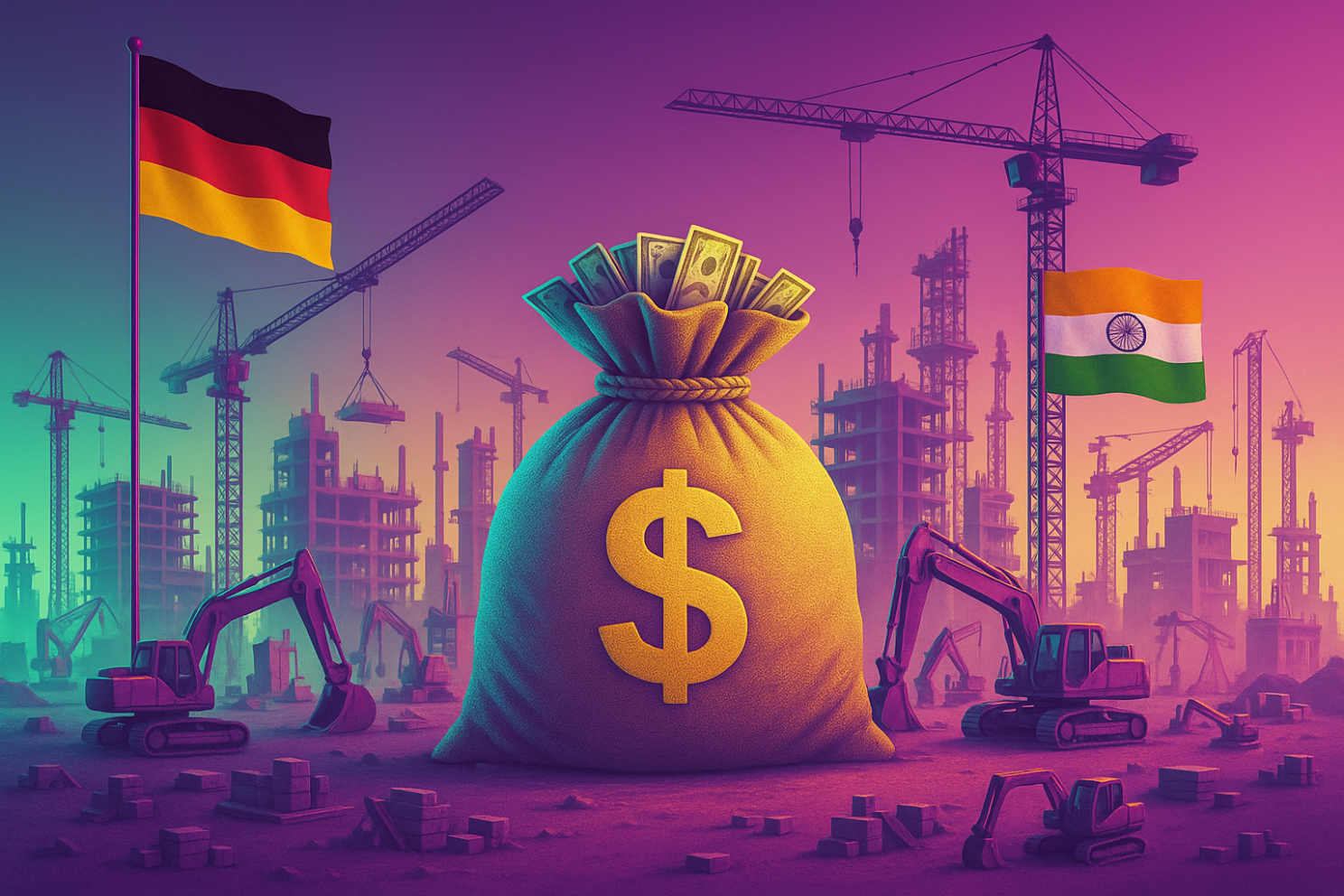Ever wonder why some of the smartest money in the world is suddenly pouring into countries that were supposedly "past their prime"? Germany just mobilized over 4 trillion dollars in investment capital while India quietly became the world's fourth-largest economy. We're witnessing two economic powerhouses reclaim their sovereignty in ways that will reshape global markets for decades.
This Week On Practical Nerds - tl;dr
Germany mobilizes 4 trillion for infrastructure and defense reinvestment
India reaches fourth largest global economy with sustained growth
Both countries asserting economic sovereignty through strategic investments
Fusion energy breakthrough could reshape global power dynamics
Bureaucratic friction remains biggest obstacle for foreign investment flows
🎧 Listen To This Practical Nerds Episode
Germany mobilizes 4 trillion for infrastructure and defense reinvestment
Why is Germany suddenly investing massively in itself again?
Germany spent over a decade in cash flow harvest mode. The Merkel administration played neutral to everyone while the country's manufacturing prowess generated steady returns without reinvestment. The "Made in Germany" brand remained the world's strongest quality perception label, but Germany wasn't betting on its own future.
That changed completely this week when Chancellor Friedrich Merz announced the "Made for Germany" initiative, mobilizing unprecedented capital for domestic investment. The numbers are staggering: 1.1 trillion from government-backed funds, 740 billion from private industry leaders and international investors, plus an estimated 2.5 trillion in foreign direct investment visibility.
This represents Germany transitioning from a mature cash cow to a growth asset again. For 15 years, investors priced Germany purely on current cash flows with compressed multiples. No one expected growth. Now growth is being baked back into the equation, and that's why capital is flooding in.
The German education system creates a unique advantage. Their dual education model means virtually everyone completes either university or advanced vocational training. You have a hyper-educated workforce that can execute on complex manufacturing and automation projects better than almost anywhere else in the world.
But the critical question remains: will Germany execute efficiently or will bureaucracy eat the returns? We've seen economies receive massive subsidies without translating to actual growth. Germany isn't corrupt, but it can waste capital through delays and complexity. Merz needs to find pragmatic shortcuts to get this money actually deployed.
German investment should focus particularly on energy infrastructure. German scientists recently achieved 43 seconds of stable fusion energy - the longest reaction ever recorded. If Germany succeeds in building resilient power infrastructure and large-scale energy storage efficiently, it could reinvent manufacturing competitiveness.
The investment coordination reveals unprecedented scale. The Made for Germany meetings included executives from SAP, Siemens, Heidelberg, and automotive leaders, plus international investors like Henry Crevice from KKR and executives from EQT. This wasn't just government planning - it represented unprecedented private-public collaboration.
Here's our provocative thesis: There's much more value to be captured by reinventing the production of a kilowatt hour of energy versus AI. Whoever reduces energy costs by another 90 percent has more world power than whoever owns OpenAI. German scientists achieving 43 seconds of stable fusion gives us hope that this transformation could happen within our lifetime.
The numbers tell the real story. The Euro has gained over 10 percent strength since the beginning of the year - not from dollar weakness, but from Euro strength. When people want to invest in Europe, they buy Euros. Increased demand drives prices up. This indicates massive capital flows are already underway.
Germany's approach to defense technology provides another compelling angle. 93 percent of European Union defense tech funding went to Germany last year. The country is building fantastic clusters backed by government becoming a customer - something that made US defense tech so powerful. But this success depends on streamlined purchasing processes and pragmatic business frameworks.
The strategic importance: Germany is betting it can reinvent energy infrastructure and manufacturing competitiveness before other nations figure out the same playbook.

India reaches fourth largest global economy with sustained growth
How does India maintain 6-7 percent real growth consistently?
India just surpassed Japan to become the world's fourth-largest economy at 4.18 trillion dollars. Germany sits at 4.7 trillion, meaning India will likely claim third place within two years. But the real story isn't the ranking - it's the growth engine behind it.
Multiple tailwinds are converging simultaneously. The government invested heavily in infrastructure over the last decade, finally building the basic rails for efficient commerce. Massive rural-to-urban migration is shifting people from agriculture to manufacturing and services. This creates a consumption flywheel as more people earn steady incomes and demand services.
India benefits tremendously from being the alternative manufacturing destination as companies diversify away from China. Apple now uses India as their primary manufacturing base for iPhones sold in the US. The country leverages its massive human capital - 20 percent of US unicorns have Indian founders, and 10 percent of Fortune 500 CEOs are of Indian origin.
But India's bureaucratic complexity around foreign investment creates significant friction. Foreign investors face weeks-long processes just to open dematerialized accounts for public stock holdings. This bureaucratic friction prevents India from capturing the foreign direct investment that China attracted so successfully in the 1990s and 2000s.
China managed that transition by requiring joint ventures while making it relatively easy for foreign capital to enter and deploy. India hasn't mastered that playbook yet. However, India has advantages that China didn't have during its growth phase.
The population averages 27-28 years old with no predetermined brand loyalties. Young consumers with disposable income for the first time create massive opportunities for new domestic brands in categories that don't require advanced manufacturing or luxury positioning.
India faces the "middle zone" challenge - fast-growing but trying to break out of low-income status to reach middle-income level, then eventually transition beyond being a middle-income country. Many large countries have gotten stuck in that middle-income phase historically.
The infrastructure buildup represents a fundamental shift. India entered the golden phase of infrastructure development, where the engine is humming along nicely. This has made moving goods, building structures, and transacting business more seamless, stimulating employment and economic activity.
India's venture ecosystem now ranks second or third globally while maintaining emerging market growth rates. This creates a weird overlap where you have a country that's simultaneously a top VC ecosystem and still in the middle zone of economic development. Some global capital allocators treat India as core portfolio, others as part of broader emerging market or Asia allocations.
The demographic dividend cannot be overstated. When you have addressable markets of tens of billions of dollars growing at double digits, combined with a young population entering the workforce and consuming more, you create natural demand engines that sustain growth beyond typical economic cycles.
The strategic importance: India represents the last major growth market with both scale and democratic institutions, making it irreplaceable for global portfolio diversification.

Both countries asserting economic sovereignty through strategic investments
What drives this simultaneous push for economic independence?
Both Germany and India are reclaiming economic sovereignty through massive domestic investment programs. It's not coincidence that this is happening simultaneously. Global capital allocation is shifting toward countries that can offer growth plus stability plus strategic independence.
Germany's approach focuses on energy infrastructure and defense manufacturing. There's more value in reducing kilowatt-hour costs by 90 percent than in owning the next AI breakthrough. When German scientists achieved 43 seconds of stable fusion energy - the longest reaction ever recorded - we saw this as potentially reshaping global energy economics.
Whoever masters cheap, abundant energy production gains more economic power than whoever dominates AI. If Germany or the EU wins fusion energy at scale, they completely transform their manufacturing competitiveness and geopolitical position. This could happen in the next 10-15 years.
India's sovereignty play centers on becoming the democratic alternative to China for manufacturing and services. The country is transitioning from being part of "emerging markets" portfolios to potentially earning dedicated India allocations from global fund managers. This shift historically preceded major asset appreciation in markets like Japan in the 1980s.
Both countries share the challenge of translating capital mobilization into actual economic output. Germany must overcome bureaucratic inefficiencies that could waste deployed capital through delays and complexity. India must streamline foreign investment processes to capture the foreign direct investment flows that powered China's earlier growth.
The demographic advantages cannot be overstated in both cases. Germany's dual education system creates a uniquely skilled workforce capable of executing complex automation projects. India's young population with rising incomes creates unprecedented consumption opportunities that existing global players find difficult to replicate elsewhere.
Both countries are moving from cash flow harvesting to growth investment modes. Germany suggests a fundamental shift from mature asset to growth story. India shows a country finally building the infrastructure foundation that had been delayed for decades.
The geopolitical context adds another fascinating layer. Neither Germany nor India currently has trade deals with the US - an expression of independent economic positioning rather than weakness. This gives both countries negotiating leverage and strategic flexibility.
Both countries position themselves as alternatives to existing power structures - Germany as Europe's manufacturing and energy hub independent of external dependencies, India as the democratic counterweight to authoritarian manufacturing models. This positioning creates optionality for global investors seeking exposure to growth markets that align with democratic institutional frameworks.
Energy security becomes paramount as global supply chains fragment. Germany's pursuit of fusion energy dominance and India's position as the democratic manufacturing alternative to China represent strategic bets that could define economic leadership for the next two decades.
The strategic importance: Economic sovereignty allows countries to set their own strategic priorities rather than optimizing purely for global capital efficiency, creating sustainable competitive advantages.

The Sovereignty Investment Framework (For Founders)
We're witnessing a fundamental shift where major economies prioritize strategic independence over pure efficiency. Germany and India demonstrate that countries with strong fundamentals can mobilize massive capital when they commit to domestic investment over cash flow harvesting.
The framework for investors: identify economies transitioning from mature cash cows to growth assets, with the human capital and institutional capacity to deploy capital effectively. Focus on countries asserting sovereignty through infrastructure, energy, and manufacturing investments rather than those optimizing purely for global integration.
What makes this moment particularly compelling is the convergence of demographic advantages, infrastructure readiness, and political will in both countries. Germany's undervalued asset status combined with India's infrastructure golden phase suggests we're seeing synchronized economic transitions that happen maybe once per generation.
The timing couldn't be more critical as global supply chains fragment and energy security becomes paramount. Germany's pursuit of fusion energy dominance and India's position as the democratic manufacturing alternative to China represent strategic bets that could define economic leadership for the next two decades. The scale of capital mobilization we're observing - over 4 trillion for Germany alone - indicates these aren't experimental initiatives but existential investments in national competitiveness.
From a portfolio perspective, both countries offer rare combinations: large addressable markets with sustained double-digit growth potential, backed by institutional frameworks capable of absorbing and deploying massive capital efficiently. The demographic tailwinds in both economies - Germany's hyper-educated workforce and India's young consumer base - create natural demand engines that can sustain growth cycles beyond typical economic expansion periods.
Historical precedent suggests that when countries with Germany and India's fundamental strengths commit to domestic reinvestment at this scale, the returns compound over decades rather than quarters. Germany's post-war rebuilding phase and China's growth trajectory in the 2000s highlight how infrastructure-led investment cycles can fundamentally reshape economic trajectories when executed with political continuity and bureaucratic efficiency.
The geopolitical dimension adds another layer of strategic importance to these sovereignty plays. Both countries are positioning themselves as alternatives to existing power structures - Germany as Europe's manufacturing and energy hub independent of external dependencies, India as the democratic counterweight to authoritarian manufacturing models. This positioning creates optionality for global investors seeking exposure to growth markets that align with democratic institutional frameworks.
Perhaps most significantly, both economies are betting on human capital advantages that are difficult to replicate quickly elsewhere. Germany's dual education system and India's demographic dividend represent decades of investment in human development that now provide competitive moats as automation and AI reshape global labor markets. Countries that combine skilled workforces with massive infrastructure investment typically capture disproportionate shares of global value creation.
What distinguishes these sovereignty investments from previous government-led initiatives is the unprecedented scale of private capital participation. Friedrich Merz's Made for Germany meetings brought together not just government officials but CEOs from SAP, Siemens, and international investors from KKR and EQT. This public-private alignment creates accountability mechanisms that purely government-led programs often lack.
Similarly, India's transition benefits from the convergence of government infrastructure investment with private sector job creation and consumer demand growth. The flywheel effect - where infrastructure enables employment, which drives consumption, which generates tax revenue for more infrastructure - represents a self-reinforcing cycle that can sustain growth beyond typical economic expansion periods.
The risk-reward calculus becomes particularly interesting when considering alternative scenarios. Both countries face the choice between continuing as mature, stable economies with modest growth or making transformational bets on their competitive advantages. Germany's energy infrastructure gamble and India's manufacturing sovereignty play represent calculated risks with asymmetric upside potential if execution succeeds.
For global capital allocators, these developments represent a fundamental reframing of emerging versus developed market categories. India's venture ecosystem ranks second or third globally while maintaining emerging market growth rates. Germany combines developed market stability with undervalued growth potential. Both countries offer exposure to secular trends - energy transition, demographic shifts, manufacturing reshoring - that will define the next economic cycle.
The bureaucratic execution risk cannot be understated. Germany's ability to streamline construction permits and regulatory processes will determine whether 4 trillion in mobilized capital translates to productive economic output. India's success in simplifying foreign investment procedures will determine whether it captures the foreign direct investment flows that powered China's earlier transformation.
The key risk factor remains execution capability - whether bureaucratic systems can adapt quickly enough to deploy capital effectively. Both countries face this same fundamental challenge of translating mobilized resources into productive economic output. Success in overcoming these friction points will determine which sovereignty bets pay off for global investors and which become cautionary tales of capital misallocation despite strong underlying fundamentals. The stakes couldn't be higher, as these decisions will likely determine economic leadership patterns for the remainder of this decade and beyond.
You Can Find More Analysis On The Practical Nerds Podcast
Spotify: https://open.spotify.com/show/1Q86tEwusNGwAmRdDqjFL4
Apple: https://podcasts.apple.com/de/podcast/practical-nerds/id1689880222
Foundamental: https://www.foundamental.com/
Subscribe to the Newsletter: https://www.linkedin.com/newsletters/practical-nerds-7180899738613882881/
Companies Mentioned
Resources or Companies Mentioned KKR: https://www.kkr.com/
SAP: https://www.sap.com/
Siemens: https://www.siemens.com/
Heidelberg Materials: https://www.heidelbergmaterials.com/
Zepto: https://www.zeptonow.com/
Apple: https://www.apple.com/
Follow The Practical Nerds
Patric Hellermann: https://www.linkedin.com/in/aecvc/
Shub Bhattacharya: https://www.linkedin.com/in/shubhankar-bhattacharya-a1063a3/
#Germany #India #EconomicSovereignty #GlobalInvestment #Infrastructure #Manufacturing #EconomicGrowth #GeopoliticalInvesting



